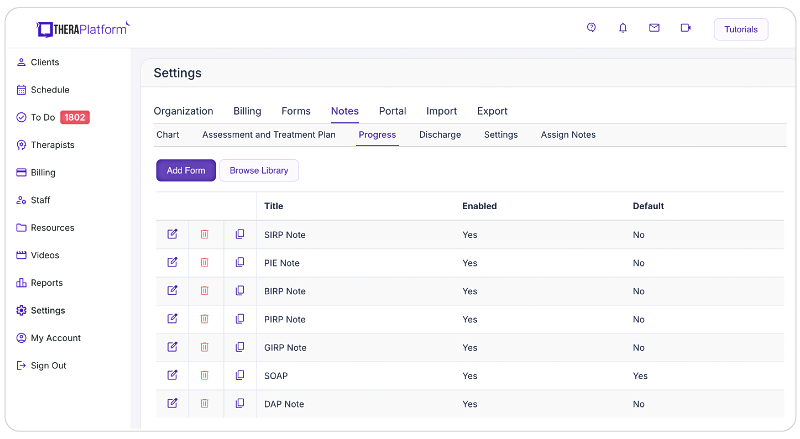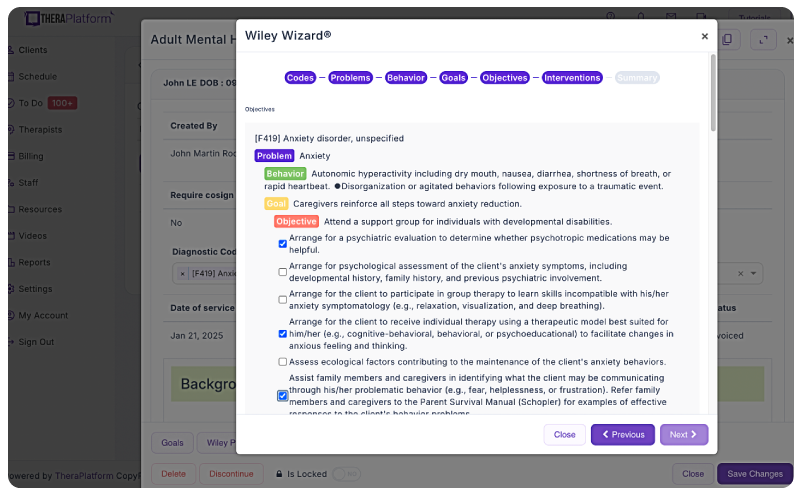GAD-7 and diagnosing Generalized Anxiety Disorder

GAD-7 or the Generalized Anxiety 7 is a screening tool used to measure Generalized Anxiety Disorder, one of the most common diagnoses that therapists see in their practices. According to the National Institute of Mental Health, an estimated 5.7% of U.S. adults will experience symptoms associated with Generalized Anxiety Disorder at some point in their lives.
Summary
- The GAD-7 is a brief, validated screening tool used to identify and measure the severity of Generalized Anxiety Disorder symptoms in adults. Download my free GAD-7 exam.
- It consists of 7 DSM-based questions rated on a 4-point Likert scale and can be administered via paper, digital form, or interview, making it accessible and flexible for clinical use.
- Administering the GAD-7 at intake and throughout treatment allows therapists to track symptom changes, evaluate treatment effectiveness, and adjust care plans accordingly.
- In addition to GAD, the GAD-7 can help screen for other anxiety-related conditions, such as panic disorder, social anxiety, and PTSD, supporting a broader understanding of client symptoms. By leveraging an EHR like TheraPlatform, clinicians can manage screeners with ease.
Streamline your practice with One EHR
- Scheduling
- Flexible notes
- Template library
- Billing & payments
- Insurance claims
- Client portal
- Telehealth
- E-fax

Because of this high prevalence of GAD, clinical practitioners need to have a reliable and valid screening tool to help screen for anxiety symptoms, severity of symptoms, and progress in treatment.
Using the GAD-7 also guides clinicians through developing a treatment plan, communicating with the client regarding progress in treatment, and evaluating treatment interventions. The GAD-7 serves as an excellent and readily accessible screening tool for therapists to use in practice.
What is the GAD-7?
The GAD-7 is a brief self report scale that helps therapists screen for probable cases of Generalized Anxiety Disorder as well as measure and continue to monitor for symptom severity for clients ages 18 and older.
The screening tool consists of 7 questions which clients can answer independently either through a paper-and-pencil format or an electronic version. The therapist can also conduct an interview type question and answer session of the GAD-7. The questions consist of various symptoms of GAD-7 identified in the DSM V.
The respondent answers each question on a four-point Likert scale as to the frequency of experiencing the various symptoms over the past two weeks (Not at all sure; Several Days; Over Half the Days; Nearly Every Day). Each answer has a point value. It should take approximately two to five minutes to complete the screening tool.
Therapists can also use the GAD-7 to assist them in screening for symptoms of Panic Disorder, Social Anxiety, and PTSD. Providers can freely access the GAD-7 by going to the website www.phqscreeners.com. Pfizer does own the copyright for the tool but has made it freely accessible to providers. Additionally, various electronic practice management systems and online telehealth therapy platforms make the GAD-7 readily available for clinicians to use.
Practice Management + EHR + Telehealth
Manage more in less time in your practice with TheraPlatform

Why use the GAD-7?
When the therapist administers the GAD-7 at intake, the outcome gives the clinician and client a clinical picture of the severity of the anxiety symptoms. The clinician can then use this information to assist with developing a more clear diagnosis for the client and in designing a more individualized treatment plan for the client. The therapist can then administer the GAD-7 during the course of treatment.
Just as physicians routinely monitor and measure for changes in their patients (ex: blood pressure checks for a patient with high blood) therapists should routinely monitor and measure for changes regarding symptom severity with clients involved in therapy. When the therapist administers the GAD-7 at intake and then during the course of treatment, the answers and total score of the tool can provide the therapist and client with an assessment of progress in treatment.
Discussions on the overall scores and answers to the questions can help the clinician and the client gain a better understanding of how the client is responding to treatment by measuring for any changes in symptom severity.
This process can also increase the individualization of treatment interventions by providing the clinician and client with an opportunity to discuss the treatment plan and any need for changes in interventions or a change in the frequency of sessions.
For example, if the GAD-7 administered during the course of treatment indicates an improvement of symptoms, it may be appropriate for the therapist and client to discuss stepping down in the frequency of sessions or continuing with the current treatment model for a period of time.
If the score indicates an increase in severity of symptoms, then it might warrant a discussion of what to do differently in treatment. These types of clinical discussions can improve the communication between the clinician and the client and increase their collaboration together on working towards treatment goals.
Free Resources for Therapists
Click below and help yourself to peer-created resources:

How to administer the GAD-7?
On the GAD-7, clients answer seven questions on a Likert scale regarding the severity of seven Generalized Anxiety Disorder symptoms from the DSM experienced within the past two weeks. Treatment providers can offer clients the opportunity to independently answer the questions prior to the session, during the session, or upon completion of the treatment session.
Some clinicians may prefer to administer the scale as part of the treatment session in an interview format. If the therapist administers the GAD-7 in an interview format, it is important that the clinician adhere to the question-and-answer format and not allow for discussion of the questions or responses during the administration time.
Following the completion of the GAD-7, the treatment session can allow for further discussion of responses, symptoms, and treatment planning based on the answers and overall score. Treatment providers may want to consider administering the tool upon intake, at regular intervals throughout treatment, and again at discharge.
GAD scoring
The GAD-7 may be completed on paper or by an electronic version. Clients rate the severity of the listed symptoms over the past 2 weeks according to the answers:
- 0=not at all;
- 1= several days;
- 2=more than half the days;
- 3=nearly every day.
The respondent is asked “Over the last 2 weeks, have you felt bothered by any of these things?”
The assessment then lists the following questions with corresponding space to answer according to the Likert scale ratings:
- Feeling nervous, anxious, or on edge?
- Not being able to stop or control worrying?
- Worrying too much about different things?
- Trouble relaxing?
- Being so restless that it is hard to sit still?
- Becoming easily annoyed or irritable?
- Feeling afraid as if something awful might happen?
Respondents then answer a final question of “If you checked off any problems, how difficult have these problems made it for you to do your work, take care of things at home, or get along with other people?
The respondent answers according to:
- Not difficult at all
- Somewhat difficult
- Very difficult; or
- Extremely difficult
The clinician then scores the tool by adding up the answers of the Likert Scale.
The totals indicate severity of anxiety symptoms.
- A score of 1 to 4 indicates minimal symptoms.
- A range of 5 to 9 indicates mild symptoms.
- Scores in the range of 10 to 14 suggest moderate symptoms.
- Scores of 15 to 21 correlate with severe symptoms.
The clinician can then use these severity ratings and answers to specific symptoms towards assigning a diagnosis and developing an appropriate treatment plan.
As a brief assessment tool with easy administration, scoring, and interpretation, the GAD-7 offers an opportunity to screen for symptoms of anxiety and measure for severity of symptoms.
Clients can complete it with ease. The short question and answer format of the tool is not overly invasive or difficult for a client to complete. The score and answers can generate a diagnostic picture of the severity of anxiety to assist with clinical discussion of the anxiety; assist in initial treatment planning; and guide the therapeutic process throughout the treatment process. The GAD-7 can serve as a reliable and valid tool to assist and guide clinicians in diagnosing and treating Generalized Anxiety Disorder in their practices.
Improving mental health assessment notes with EHR software
EHR software and practice management tools, such as TheraPlatform, offer numerous advantages in creating accurate, efficient, and organized notes.
Top 7 benefits of using EHR for notes management
Manually writing and storing notes can be cumbersome for many therapists. That process can be further exacerbated by simple document requests that include locating, faxing or scanning documents.
Features like customizable templates, secure storage, easy sharing, duplication, electronic signatures, and efax integration, streamline the note process, optimizing therapy documentation and workflows.
- Consistent notes with template library: EHRs equipped with a library of note templates enable therapists to create standardized and concise notes quickly. This feature ensures consistency across notes, making it easier to review client progress. Additionally, EHRs provide centralized storage and management of notes, enhancing accessibility and organization.

Screenshot of TheraPlatform’s built-in therapy note template library. Notes are one of dozens of types of templates that can be used as is or modified to meet the needs of a therapist in private practice
- Customizable notes: Not all EHRs offer customizable note templates tailored to therapists' unique needs. However, with a robust and user-friendly note template builder, therapists can customize note templates to align with their preferred note-taking style. This flexibility allows for efficient data entry, whether therapists prefer separating sections or using a single note field or checkboxes for mental status or techniques.

- HIPAA-compliant note storage: EHRs prioritize data security by implementing bank-level encryption to safeguard notes and other client information. TheraPlatform, for instance, ensures HIPAA compliance by offering signed, legally-binding Business Associate Agreements to protect Protected Health Information (PHI) between compliant entities.
- Seamless note sharing with clients: Clients may request access to their notes to better understand their treatment or keep them for record-keeping purposes. Using an EHR, therapists can securely share notes with clients, saving time compared to paper-based practices. TheraPlatform, a HIPAA-compliant EHR for therapists, facilitates secure note sharing with clients.

- Duplicate notes: In cases where the data remains the same across multiple sessions, duplicating notes can save time. This feature is particularly useful when clients exhibit repetitive behaviors or show minimal progress, allowing therapists to refer back to previous notes for accurate documentation.
- Client signatures made easy: EHRs streamline the process of requesting client signatures. TheraPlatform's Pro and Pro Plus plans enable therapists to request electronic signatures directly on notes. Clients can conveniently download and print the documents requiring their signatures.
- Easier faxing: TheraPlatform offers efax integration as an add-on feature, eliminating the need for toggling between multiple services. This integrated solution allows therapists to send and receive documents, including notes, via fax directly from TheraPlatform. Additionally, received faxes can be easily filed under the respective client's charts.
Additional tools and outcome measures to help with data collection and progress monitoring
Therapists can also take advantage of EHRs (such as TheraPlatform) that offer integrations with Wiley treatment planners to ensure consistent data collection on progress from session to session. The best part about partnering with a modern EHR is the time you save on formulating the actual notes and scoring.
What is Wiley Treatment Planner?
Wiley Treatment Planner is a widely used clinical resource designed to help mental health professionals and other therapists efficiently create treatment plans for their clients. In addition to treatment plans, the company also provides prewritten therapy notes for some diagnostic codes. It is part of the "PracticePlanners" series published by Wiley.
Features of Wiley Treatment Planner includes:
- Prewritten, evidence-based treatment goals, objectives, and interventions
- Treatment planners tailored to specific populations and problems, including adults, children, adolescents, couples, families, addictions, and more
- Alignment with the diagnostic criteria from the DSM-5 and ICD-10
- Prewritten therapy notes
Is there an online version of Wiley Treatment Planner and how can I get the Wiley Treatment Planner?
Wiley Treatment Planner company partnered with a select number of EHRs for mental health providers to make treatment planners available online. TheraPlatform’s EHR offers the Wiley Treatment Planner as an add-on for both assessment and treatment plans and therapy notes, such as notes. You can edit prewritten notes and add your own with any therapy template on TheraPlatform.

Screenshot of Wiley Treatment Planner integration into TheraPlatform illustrating how areas like problems, behaviors, goals and objectives can be completed with pre-populated, research-based statements.
Save time with automatically scored outcome measures
Mental health therapists can use outcome measures to document progress, track a variety of key clinical indicators, helping providers make data-driven decisions, improve communication with clients, and improve client outcomes. Additionally, outcome measures help therapists adhere to compliance requirements and provide documentation needed to support reimbursement.
Watch this video to learn about how to autoscore outcome measures
→ Sign up for a Free Frial
While outcome measures clearly provide benefits to both clients and therapists, they can be time-consuming, especially if clinicians score responses manually.
However, many aspects of outcome measures can be automated through an EHR like TheraPlatform:
- Sending measurements: Common assessments such as the PHQ-9 or GAD-7 can be automatically sent to clients and stored in their records or they can be scheduled on regular intervals.
- Auto scoring: TheraPlatfrom automatically scores and sums totals for common outcome measures.
- Report building and analysis: Results can be analyzed over time, with visual charts showing progress on rates of severity and session-to-session progress.
By regularly using these measures, therapists can gain valuable insights, tailor interventions, and improve client outcomes while demonstrating the effectiveness of their care without manual entry.

By leveraging the capabilities of EHR software like TheraPlatform, therapists can enhance the accuracy, efficiency, and accessibility of their notes, allowing them more time to enhance client care.
Streamline your practice with One EHR
- Scheduling
- Flexible notes
- Template library
- Billing & payments
- Insurance claims
- Client portal
- Telehealth
- E-fax

Resources
Theraplatform is an all-in-one EHR, practice management and teletherapy solution with AI-powered note taking features that allows you to focus more on patient care. With a 30-day free trial, you have the opportunity to experience Theraplatform for yourself with no credit card required. Cancel anytime. They also support different industries including mental and behavioral health therapists in group practices and solo practices.
More resources
- Therapy resources and worksheets
- Therapy private practice courses
- Ultimate teletherapy ebook
- The Ultimate Insurance Billing Guide for Therapists
- The Ultimate Guide to Starting a Private Therapy Practice
Free video classes
- Free mini video lessons to enhance your private practice
- 9 Admin tasks to automate in your private practice
References
Spitzer RL, Kroenke K, Williams JBW, Lowe B. A brief measure for assessing generalized anxiety disorder - The GAD-7. Archives of Internal Medicine. 2006;166:1092-1097. https://www.mirecc.va.gov
Pfizer GAD-7 screener



